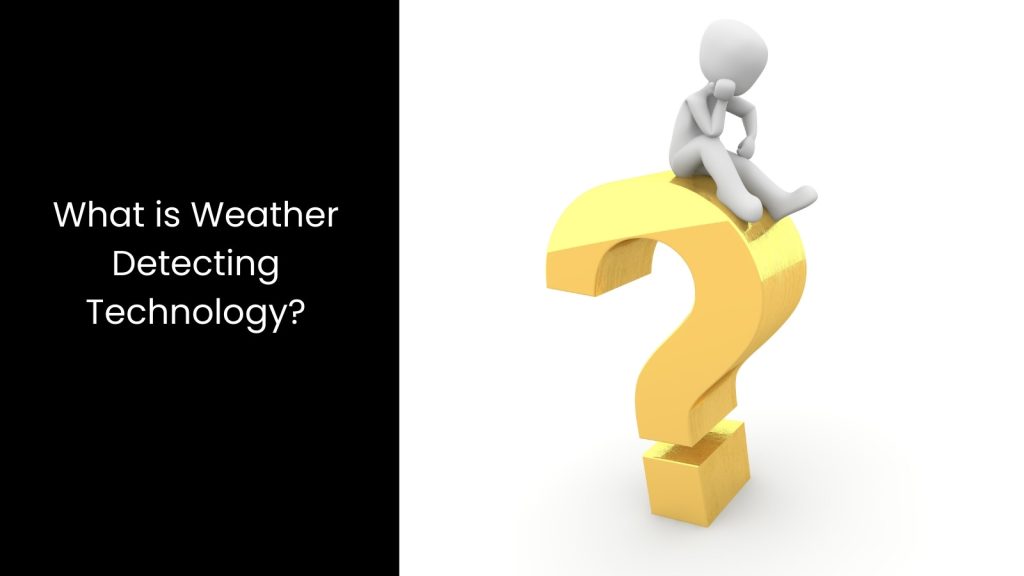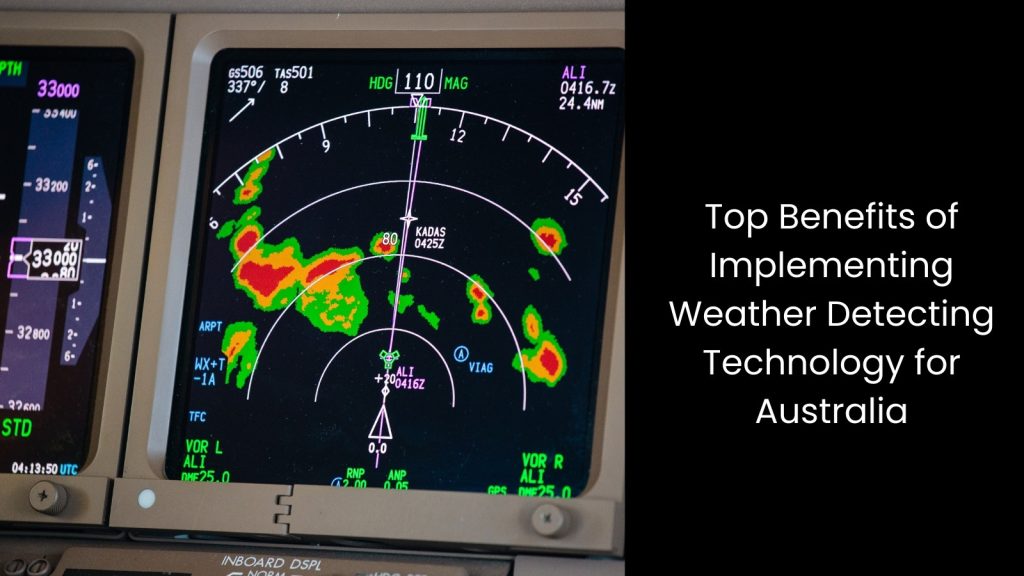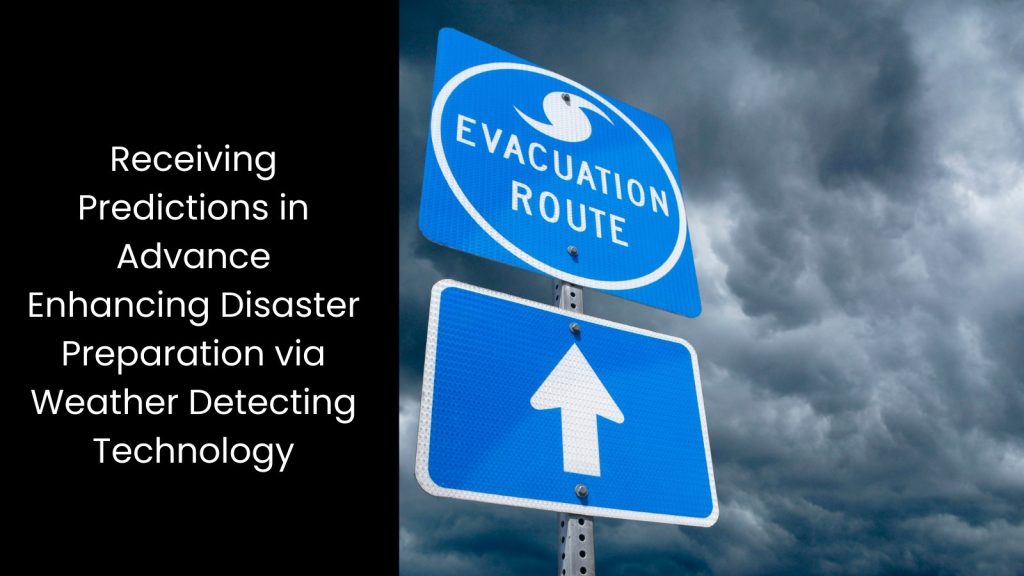Did you know that Australia experiences some of the most extreme weather conditions in the world? Bushfires, cyclones, severe floods, droughts, and whatnot? This presents an immense challenge for the Australian authorities to stay updated on what is occurring in their weather zone. That is why they find weather-detecting technology not just important but essential for Australia’s safety and sustainability.
In this article, we understand the importance of utilising weather-detecting technology for Australia.
In this article, we understand the importance of utilising weather-detecting technology for Australia.
We will look into
- What is Weather Detecting Technology?
- Top Benefits of Implementing Weather Detecting Technology for Australia
- Real-Time Climate Change Monitoring
- Accurate Forecasting
- Preparing for Disasters in Advance
- Infrastructure Protection
3. Receiving Predictions in Advance Enhancing Disaster Preparation via Weather Detecting Technology
What is Weather Detecting Technology?

- Weather-detecting technology refers to a set of tools, systems, and devices that track and analyse atmospheric conditions in real-time to provide accurate weather forecasts and warnings.
- You can actually call it a ‘fusion of capabilities’ as this technology uses sensors, satellites, radar, and computer models to monitor various elements like temperature, humidity, wind speed, and precipitation. As it collects and analyses this data, weather-detecting systems can predict short-term and long-term weather patterns, helping people and businesses make more informed decisions.
- In Australia, where extreme weather conditions like bushfires, floods, cyclones, and droughts pose significant risks, weather-detecting technology plays a vital role. It helps government agencies, emergency responders, farmers, and infrastructure planners to prepare for and manage weather-related challenges.
- These technologies also help predict climate trends, monitor environmental changes, and provide early warnings for disasters, saving lives and protecting properties. With weather-detecting systems, the agricultural sector can optimise planting and harvesting schedules based on expected rainfall, while energy companies can manage solar and wind energy production more efficiently. By offering precise and timely information, weather-detecting technology supports decision-making across industries and enhances public safety.
Top Benefits of Implementing Weather Detecting Technology for Australia

Real-Time Climate Change Monitoring
Weather-detecting technology helps Australian authorities provide continuous, precise data on atmospheric and environmental conditions. Authorities can use sensors, satellites, and radar systems to track changes in temperature, rainfall, wind patterns, and sea levels across vast regions of the country.
When they analyse this data in real time, they can detect shifts in climate trends, identify extreme weather events, and monitor long-term changes like rising temperatures or increased droughts. This information allows authorities to understand the immediate impacts of climate change on ecosystems, agriculture, and urban areas.
For example, as weather-detecting systems track rising sea levels and coastal erosion, government agencies can plan and implement preventive measures to protect vulnerable coastal communities. In rural areas, real-time data helps monitor droughts and bushfire risks, allowing authorities to allocate resources for disaster response more effectively.
Real-time monitoring also supports decision-making in water management, ensuring that Australia’s water supply remains secure in the face of shifting rainfall patterns. Additionally, these systems help track greenhouse gas emissions, contributing to Australia’s efforts to reduce its carbon footprint and meet international climate commitments.
In addition to providing constant updates on weather and climate changes, weather-detecting technology helps Australian authorities respond swiftly to both short-term and long-term climate threats. As you can see, it makes the country more resilient to climate change impacts.
When they analyse this data in real time, they can detect shifts in climate trends, identify extreme weather events, and monitor long-term changes like rising temperatures or increased droughts. This information allows authorities to understand the immediate impacts of climate change on ecosystems, agriculture, and urban areas.
For example, as weather-detecting systems track rising sea levels and coastal erosion, government agencies can plan and implement preventive measures to protect vulnerable coastal communities. In rural areas, real-time data helps monitor droughts and bushfire risks, allowing authorities to allocate resources for disaster response more effectively.
Real-time monitoring also supports decision-making in water management, ensuring that Australia’s water supply remains secure in the face of shifting rainfall patterns. Additionally, these systems help track greenhouse gas emissions, contributing to Australia’s efforts to reduce its carbon footprint and meet international climate commitments.
In addition to providing constant updates on weather and climate changes, weather-detecting technology helps Australian authorities respond swiftly to both short-term and long-term climate threats. As you can see, it makes the country more resilient to climate change impacts.
Accurate Forecasting
This technology tracks crucial weather elements like temperature, humidity, wind speed, and atmospheric pressure. This way, it gives authorities a comprehensive view of current and future weather conditions.
Then what will occur? Using this data, advanced computer models can generate precise weather forecasts that allow authorities to predict events like storms, heatwaves, floods, and bushfires with greater accuracy. In a country like Australia, having accurate forecasts is essential for effective planning and public safety.
One of the major benefits of the latter is that this technology also helps farmers plan their planting and harvesting schedules by providing accurate information on rainfall and temperature changes. In the energy sector, it helps manage the production of solar and wind power by predicting weather patterns that affect energy generation. Authorities can also monitor air quality and issue warnings during hazardous weather conditions like dust storms or heat waves, protecting the health of vulnerable populations.
Moreover, accurate forecasting helps emergency services allocate resources and prepare for potential disasters more effectively. This will reduce response times and improve outcomes. In urban areas, authorities use weather data to manage transportation systems, reducing disruptions caused by adverse weather.
Then what will occur? Using this data, advanced computer models can generate precise weather forecasts that allow authorities to predict events like storms, heatwaves, floods, and bushfires with greater accuracy. In a country like Australia, having accurate forecasts is essential for effective planning and public safety.
One of the major benefits of the latter is that this technology also helps farmers plan their planting and harvesting schedules by providing accurate information on rainfall and temperature changes. In the energy sector, it helps manage the production of solar and wind power by predicting weather patterns that affect energy generation. Authorities can also monitor air quality and issue warnings during hazardous weather conditions like dust storms or heat waves, protecting the health of vulnerable populations.
Moreover, accurate forecasting helps emergency services allocate resources and prepare for potential disasters more effectively. This will reduce response times and improve outcomes. In urban areas, authorities use weather data to manage transportation systems, reducing disruptions caused by adverse weather.
Preparing for Disasters in Advance
Weather and disaster are like two sides of a coin. Nobody knows which side will come into play at the next moment.
This is where the latter provides real-time data and accurate forecasts that allow them to anticipate extreme weather events before they happen. With tools like satellites, radar systems, and weather stations, authorities can track dangerous conditions.
This early detection enables them to issue timely warnings to the public and organise evacuation plans if necessary. When weather-detecting technology identifies a developing cyclone, authorities can alert coastal communities to prepare for potential impacts, reducing the risk of casualties and damage. In bushfire-prone areas, weather technology monitors wind speed, temperature, and humidity levels to predict fire outbreaks, helping emergency services preposition resources like fire trucks and personnel.
Since it is possible to know where and when a disaster might strike, authorities can also plan the allocation of supplies such as food, water, and medical aid. This wise approach helps protect lives and minimise damage to property and infrastructure. Weather-detecting technology also helps disaster recovery efforts by tracking ongoing weather patterns during and after the event, ensuring that emergency teams can operate safely.
This is where the latter provides real-time data and accurate forecasts that allow them to anticipate extreme weather events before they happen. With tools like satellites, radar systems, and weather stations, authorities can track dangerous conditions.
This early detection enables them to issue timely warnings to the public and organise evacuation plans if necessary. When weather-detecting technology identifies a developing cyclone, authorities can alert coastal communities to prepare for potential impacts, reducing the risk of casualties and damage. In bushfire-prone areas, weather technology monitors wind speed, temperature, and humidity levels to predict fire outbreaks, helping emergency services preposition resources like fire trucks and personnel.
Since it is possible to know where and when a disaster might strike, authorities can also plan the allocation of supplies such as food, water, and medical aid. This wise approach helps protect lives and minimise damage to property and infrastructure. Weather-detecting technology also helps disaster recovery efforts by tracking ongoing weather patterns during and after the event, ensuring that emergency teams can operate safely.
Infrastructure Protection
Do you know that Australia loses an average of $8.8 billion per year due to damage caused by floods?
This may be why Australian authorities put a lot of emphasis on infrastructure protection. The latter technology allows them to anticipate and prepare for extreme weather conditions that could damage critical assets like roads, bridges, railways, and power lines.
With systems like radar, satellites, and weather stations, authorities monitor temperature changes, rainfall, wind speeds, and other weather factors that could impact infrastructure. For example, during heavy rainfalls, this technology helps track potential flood risks in vulnerable areas, allowing authorities to take preventive measures such as closing roads or reinforcing bridges to minimise damage.
These actions can help prevent fires from spreading to highways, electrical grids, or communication networks, which are essential for daily operations. Weather-detecting technology also helps authorities prepare for high winds that could bring down power lines or damage buildings, ensuring that maintenance crews are ready to respond quickly to repairs.
In the same way, in coastal regions, authorities rely on weather technology to track storms and cyclones, allowing them to protect ports, bridges, and coastal highways from storm surges and high waves. In another way, by monitoring temperature fluctuations, this technology helps authorities protect infrastructure from heat-related issues, such as road surface cracking or train tracks warping.
So, as it is evident, this way, Australian authorities can reduce the risks of weather-related damage, plan timely maintenance, and ensure that critical infrastructure remains operational during extreme weather events.
This may be why Australian authorities put a lot of emphasis on infrastructure protection. The latter technology allows them to anticipate and prepare for extreme weather conditions that could damage critical assets like roads, bridges, railways, and power lines.
With systems like radar, satellites, and weather stations, authorities monitor temperature changes, rainfall, wind speeds, and other weather factors that could impact infrastructure. For example, during heavy rainfalls, this technology helps track potential flood risks in vulnerable areas, allowing authorities to take preventive measures such as closing roads or reinforcing bridges to minimise damage.
These actions can help prevent fires from spreading to highways, electrical grids, or communication networks, which are essential for daily operations. Weather-detecting technology also helps authorities prepare for high winds that could bring down power lines or damage buildings, ensuring that maintenance crews are ready to respond quickly to repairs.
In the same way, in coastal regions, authorities rely on weather technology to track storms and cyclones, allowing them to protect ports, bridges, and coastal highways from storm surges and high waves. In another way, by monitoring temperature fluctuations, this technology helps authorities protect infrastructure from heat-related issues, such as road surface cracking or train tracks warping.
So, as it is evident, this way, Australian authorities can reduce the risks of weather-related damage, plan timely maintenance, and ensure that critical infrastructure remains operational during extreme weather events.
Receiving Predictions in Advance Enhancing Disaster Preparation via Weather Detecting Technology

Since you have read this whole article, now you may understand how important it is to receive predictions in advance to make a country or region prepared for disasters. Weather Detecting Technologies come into the spotlight due to their power, coupled with Predictive Analytics and Satellite technologies, to offer unparalleled disaster preparation capabilities. These tools empower authorities to anticipate extreme weather events well in advance, enabling rapid, informed decisions. For a ‘prepared nation’, weather-detecting technology is a must-have strength.







